5 Techniques to Learn How to Cook Beets Like a Boss (Plus 9 Recipes)
Feel the beet.

Interested in learning how to cook beets, but having a hard time getting over childhood memories of less than palatable concoctions? You’re not alone.
The first time I tried beets, I was not a fan. My mother, of German extraction, was a fan of the sliced, pickled beets that slid out of a jar. Of my four siblings, I was the one with the most adventurous palate, but even though the jewel-toned slices were enthralling, I couldn’t get over the cloying flavor of what, to me, tasted like pickled dirt.
Luckily, I have since seen the error of my ways; beets are a delicious treat that are available in many different colors and shapes. What had originally seemed to be a “dirt” taste reveals itself to be the aroma of minerals and earth. The secret is in learning how to cook beets properly.
Beet Varieties: All About Color
Beets come in many varieties and, depending on where you live, they might be in season all year round. That being said, most take advantage of beets in the winter, as they add brightness to the otherwise muted root vegetable tones of the season. Think of them like winter’s tomato, bright, versatile, and full of both nutrition and flavor. The most common variety of beet is the table beet or red beet, but beets exist in many shapes and colors:

Yellow beet image via Shutterstock
- Detroit Dark Red is a red heirloom variety
- Golden beets have a pale yellow color and a milder flavor than their red cousins
- Chioggia beets are known for their candy-striped interior
- Crapaudine beets are long and narrow with a rich, earthy flavor
- Albina Vereduna is a sweet, white beet originally bred as a sugar beet
While it’s always a good idea to choose organic, this is especially true with beets, which are thin-skinned and spend all of their time underground, where they can easily absorb herbicides and pesticides.
While many assume that you have to be wary of GMOs when it comes to beets, this is a common misconception. While about 90 percent of sugar beets grown in the U.S. are genetically modified, you’ll be hard-pressed to find GMO table beets even though genetically modified beets have bee approved by the FDA, an April 2015 Time article reported that they are not currently in production.
Health Benefits of Beets
Beets were first cultivated by the ancient Romans, but it wasn’t until the discovery that beet sugar could be extracted from the root that their value truly grew.
However, their sweetness is far from their only benefit: beets frequently make their way to the top of lists of the world’s healthiest foods, thanks to their unique phytonutrients known as betalains. Two of these, betanin and vulgaxanthin, have been shown to have antioxidant and anti-inflammatory properties. Beets also contain lutein (though to make the most of this nutrient, choose yellow rather than red beets).
The health benefits of beets also include nutrients like folate, manganese, and potassium. Beets are also rich in nitrates, which are not only beneficial for those with high blood pressure, but are said to help increase the effectiveness of your workout, so consider beets or beet juice as a pre-workout snack.
How to Prepare Beets
Preparing beets depends a bit on how you intend to cook them, but there are a few basic steps to get you started.
Firstly, if you have purchased beets with green tops, be sure to remove them once you get home – they will continue to leech nutrients out of the beets as they sit. That said, only remove to about 2 inches above the actual beet, otherwise you might have a mess of beet juice on your hands.
When ready to cook, clean the beets thoroughly. Like potatoes, beets are often covered in soil; you may use a sponge or steel wool to clean them.
Depending on the cooking technique you are using, you may wish to peel your beets while they are still raw. If this is the case, bear in mind that beet juice does stain. Try to peel beets on a glass cutting board or on a plate to avoid staining your plastic or wooden cutting board, and wear gloves if you do not want to stain your hands.
If you do manage to stain your skin, you can use an exfoliating mixture of salt and lemon juice to clean your hands — just be sure to moisturize well afterwards.
How to Cook Beets
1. Slow Roasting
This technique takes a long time, but you’ll be rewarded with a rich, concentrated flavor. And while the cooking time is lengthy, the work required is very minimal.
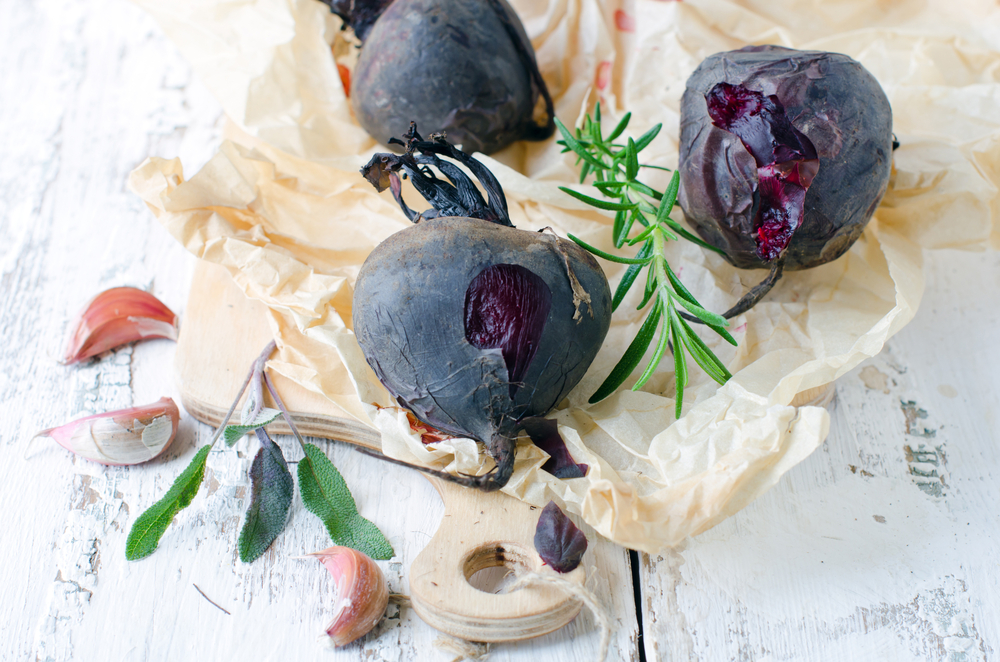
Roasted beet image via Shutterstock
Wash the beets, leaving the skins in tact. Place each beet on a piece of aluminum foil, and drizzle with olive oil and a pinch of salt. Wrap in the foil, and place on a baking sheet. Roast at 400 degrees Fahrenheit for about an hour, until the beet is tender to the core when pierced with a skewer. Cool the beets and store them in the fridge for up to a week.
When ready to use, simply peel off the skin, which should come off quite easily.
2. Quick Roasting
If you don’t have time to wait for your beets to roast whole, you can speed up the process by cutting them first. Peel the beets raw, then slice or chop into chunks. Place on a baking sheet with olive oil and salt, and roast at 400 degrees Fahrenheit for 30-40 minutes, until tender.
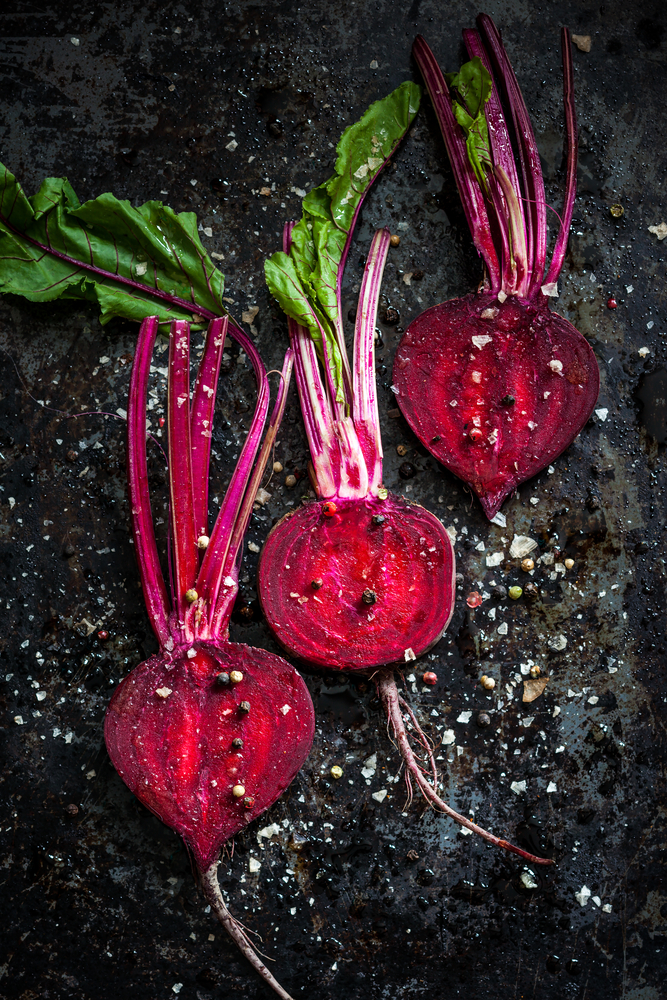
Roasted beet image via Shutterstock
3. Boiling
Boiling beets is easy and doesn’t concentrate their flavor nearly as much as roasting does, giving you a far more delicate-tasting beet.
It’s best to boil beets whole to keep their color from leeching out; simply place them in a pot of water seasoned with a bit of vinegar or lemon (a further deterrent to the juice staining everything it touches), and cook for about 1 hour. Rinse under cold water when cooked, and the skins should slip right off.
4. Steaming
Steaming is the quickest beet cooking technique there is — 15 minutes, and you’re done. This is largely due to the fact that cutting the beets before steaming them won’t cause them to lose any flavor, as it does when boiling.
For the easiest steaming technique, quarter the unpeeled beets and steam them for 15 minutes. Remove the skins once the beets are steamed.
5. Raw Beets
Beets are delicious raw; the only thing to be aware of is that they should be sliced thinly for best results.
Use a mandoline or a very sharp knife to slice the beets into rounds, and then dress with your favorite dressing. This technique is particularly lovely with Chioggia beets, as the candy-striping may bleed with other techniques.

Chioggia beet image via Shutterstock
9 Yummy Beet Recipes
Beets are consumed the world over, particularly in Eastern Europe, where beet soup is a popular dish, and in India, where beets are often prepared in salads or condiments. Here are some of our favorite beet recipes.

Image: Anna Brones
1. Beet Pesto
This beet pesto is a beautifully colorful condiment for any sandwich. Feta or goat cheese and balsamic vinegar season the earthy beets just enough, and mint and walnuts add unique flavor in place of the more traditional basil and pine nuts.
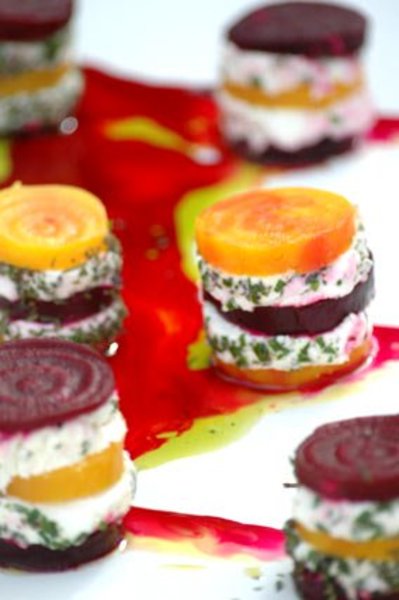
Image: Laura Klein
2. Roasted Golden and Red Beet Stacks with Goat Cheese
This beet salad pairs eternal culinary BFFs beets and goat cheese, but in a novel way. These stacks are absolutely gorgeous and deceptively simple to prepare.

Photography by Julie Bidwell
3. Golden Beet and Blackberry Salad
Beet salads are no stranger to bright pops of color, but the use of less common golden beets in this salad almost makes it more jarring than the red version. Green chives and deep blackberries complete the tableau.

Photos by Ally-Jane
4. Homemade Horseradish with Beets
This combo is an Eastern European classic; earthy beets and bright, pungent horseradish make a tasty condiment for sandwiches or pretty much any roast.
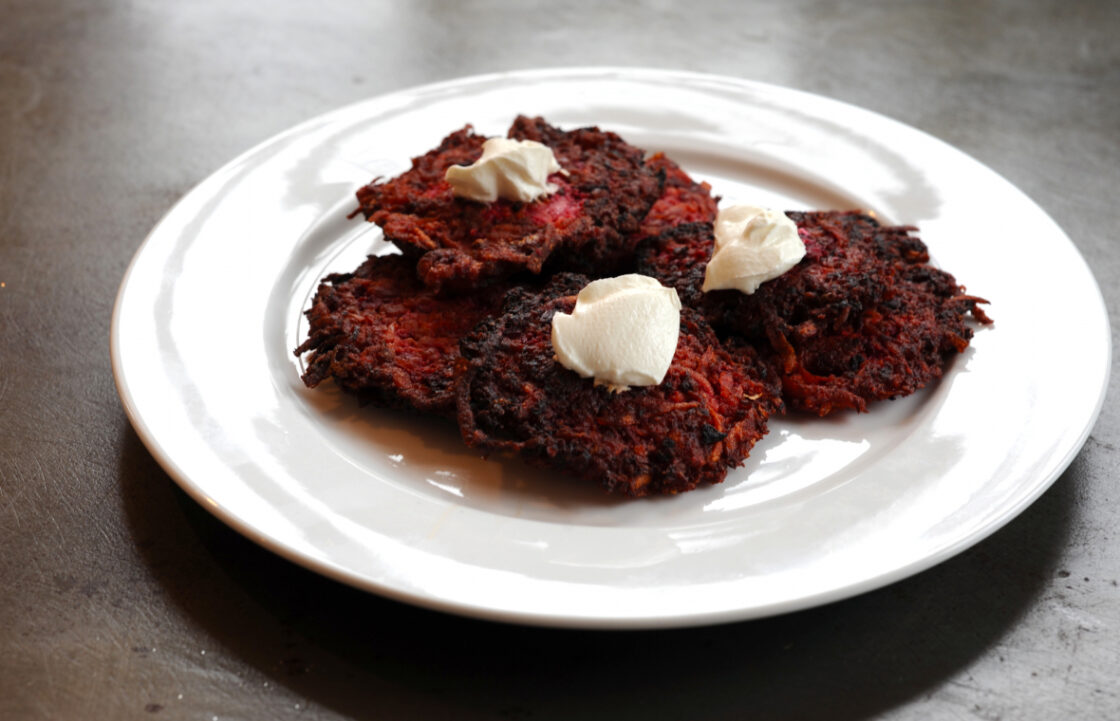
Photos by Ally Jane Grossan
5. Beet and Potato Latkes
Classic potato pancakes get a pretty makeover when raw beet is added to the mix. Beet latkes aren’t just more colorful; they’re also tastier and healthier too.

Photos by Erin Scott
6. Pickled Beets
The cloying, unpleasant flavor of the canned pickled beets I tried in my youth is nowhere to be found with this tasty recipe, spiced with cinnamon, cloves, and allspice.

Image: Muffet
7. Borscht
No beet recipe roundup would be complete without mention of borscht. This beautiful pink soup is made with bone broth, cabbage, caraway, and dill.

Image by Adam Slama
8. Beet Ice Pops
You shouldn’t be surprised, given the sugar content of beets, that they can be used in sweet dishes as well. These beet ice pops are rich and silky smooth thanks to the tart addition of sour cream.
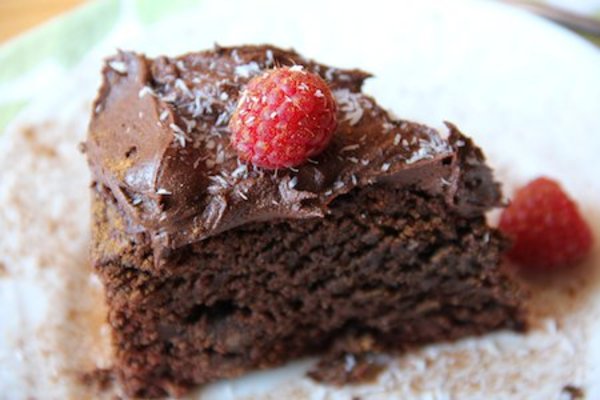
Image Credit: GlowKitchen
9. Vegan Beet Chocolate Cake
This vegan chocolate cake gets some of its sweetness from beets, though you wouldn’t know it from looking at it. It’s dense and rich, but not so decadent that you can’t enjoy it guilt-free.
Bonus: Beet Greens
When you buy a bunch of beets, keep those green tops! Beet greens are full of all of the same vitamins and minerals as the beets themselves, with an added punch of lutein. They’re absolutely delicious sautéed as a side dish, for example these easy garlicky beet greens.
Did we miss any of your favorite ways to serve beets? Let us know on Facebook or via Twitter @organicauthorit.
Related on Organic Authority
4 Recipes for Beets for a Delicious Meatless Monday (#2 Has a Whole Lot of Wow Factor)
Are Beets the New Kale?
Beets for Breakfast? 10 Delicious Beet Recipes
Beet image via Shutterstock

